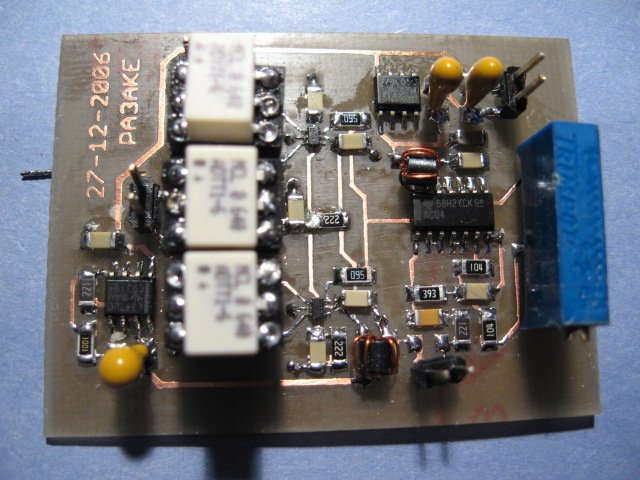|
Mini-Circuits ADTT1-6

The next 1:1 transformer tested is the ADTT1-6. The following table lists the results:
| FSA3157 + ADTT1-6 + 74AC04 |
Vdd = 7.0V, Vbias = 2.5V |
Best bias |
| Band |
BPF |
mixer |
MDS -dBm |
IF rej |
spur |
mixer IIP3 (dBm) @ 20KHz spacing |
Bias |
IIP3 |
| IL |
CL |
- |
+ |
|
avg |
-6 |
-3 |
0 |
+3 |
+5 |
|
0 |
| -dB |
-dB |
BPF |
BPF |
-dB |
dB |
dBm |
dBm |
dBm |
dBm |
dBm |
V |
dBm |
| 160 |
3,3 |
4,68 |
133,5 |
130,0 |
49,2 |
|
|
|
43,7 |
|
|
1,8 |
44,7 |
| 80 |
1,4 |
4,68 |
133,5 |
132,0 |
49,6 |
|
45,7 |
47,5 |
48,7 |
48,7 |
48,5 |
1,2 |
51,2 |
| 40 |
2,3 |
4,76 |
133,5 |
131,0 |
50,0 |
|
|
|
47,4 |
|
|
2,5 |
47,4 |
| 30 |
3,4 |
4,80 |
133,5 |
130,0 |
49,6 |
|
|
|
46,3 |
|
|
2,6 |
46,3 |
| 20 |
3,4 |
4,84 |
133,5 |
129,5 |
56,0 |
|
|
|
44,9 |
|
|
2,6 |
45,2 |
| 17 |
3,0 |
4,96 |
133,5 |
129,5 |
52,8 |
|
|
|
44,3 |
|
|
2,5 |
44,3 |
| 15 |
3,9 |
5,08 |
133,5 |
128,5 |
56,0 |
0,3 |
|
|
42,6 |
|
|
2,5 |
42,6 |
| 12 |
3,7 |
5,12 |
133,0 |
129,0 |
54,0 |
|
|
|
40,6 |
|
|
2,5 |
40,6 |
| 10 |
2,3 |
5,20 |
133,0 |
130,5 |
41,2 |
|
|
|
42,3 |
|
|
2,6 |
42,3 |
| 6 |
|
5,40 |
131,0 |
|
46,8 |
|
|
|
39,2 |
|
|
2,5 |
39,2 |
| 4 |
|
5,88 |
131,0 |
|
27,2 |
|
|
|
37,9 |
|
|
2,5 |
37,9 |
Conversion loss is excellent, below -5,2dB on HF but steadily worsening on higher frequencies.
Average spur level with the ADTT1-6 is fair at 0,3dB. Note that this applies to a mixer adjusted for best RF-IF isolation, so nothing special was done to minimize the spur level. When adjusted to minimize the spur levels it can be reduced to -3,2dB average although at the expense of reduced RF-IF isolation (-35dB)
With regard to the spur rejection the ADTT1-6 is not quite as good as the ADTT1-1. This can be predicted from the spec-sheets too. Phase and amplitude balance are not so good at VHF causing bad symmetry for the spurs when adjusted for best symmetry at the operating frequency.
RF-IF isolation is excellent, better than -50dB, if band specific adjustments are made. The levels in the table are for the best isolation on 15M.
The ADTT1-6 combination has the best average bias point at 2.5V. On 160M and 80M however the IP3 can be noticeably improved with a lower bias point. No steep dips on any band though.
This configuration behaves very well with regard to IP3's 3rd order law. The IP3 is very flat over a wide input range on 80M!
Once again we find a 1:1 transformer that exhibits >+40dBm IP3 on all HF bands and almost on 6M.
Back to Transformers
Back to the TOC
|